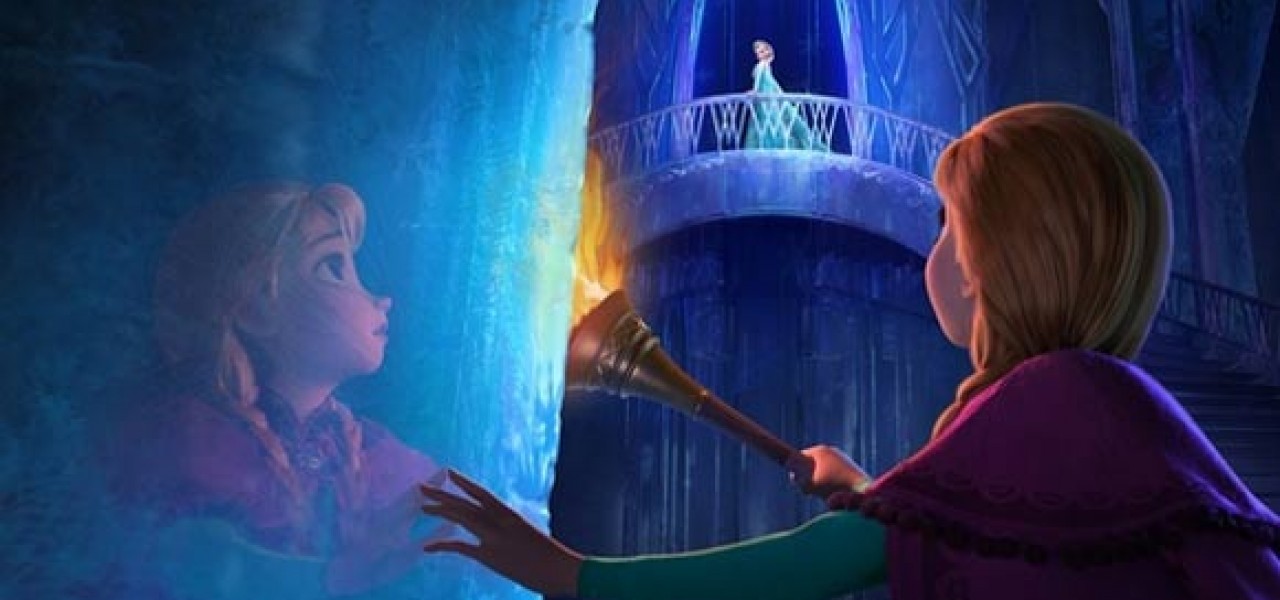
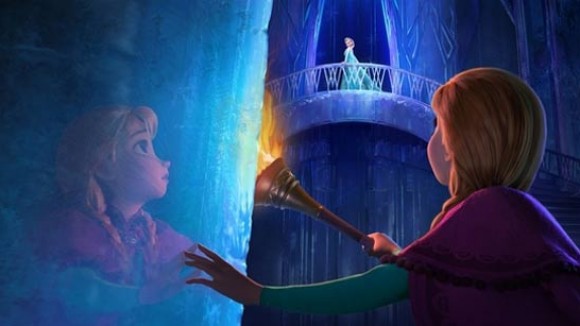
Disney’s ‘Frozen’: The Acting and Performance Analysis
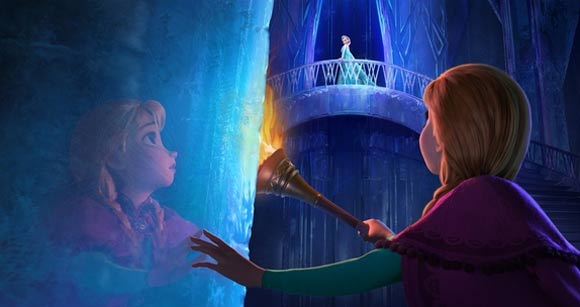
ED HOOKS is the author of Acting for Animators, (revised third edition, Routledge, 2011). Ed pioneered Acting for Animators in 1998 while working with the animators at PDI/DreamWorks in northern California, and teaches the Acting for Animators masterclass internationally. For more information about his practice, visit EdHooks.com
DISNEY’S FROZEN WILL SOON MERIT its own chapter in the entertainment industry Big Book. The 2014 Oscar winner for best animated feature has earned over US$1 billion at the box office, currently the second highest-grossing animated feature in history, behind Toy Story 3. The movie’s phenomenal financial success has obscured under-the-hood examination of its performance engine. As an acting teacher, I am an artistic purist; grosses and popularity awards don’t mean much to me. My standard of measurement is the emotional impact a movie has on its audience and its elegance as a work of art. Frozen is beautiful to see, fun to sing along with and is a modern day marketing marvel, but the script has structural and performance issues that are worth examining because they impact directly on acting.
In a nutshell, Frozen tells the story of a fairy tale princess named Anna who must find her runaway, freshly crowned, ice-and-snow-controlling queen sister, Elsa, and in the process rescue the kingdom of Arendelle from perpetual winter. Along the way, she accumulates and interacts with a cast of characters that are, by turns, funny, romantic and dangerous. In the end, Anna and Elsa learn the value of selfless love and form a new lifetime sisterly bond as a result.
Introduction: Acting and Story are joined at the hip
Even the most talented animator can work only with the character that is given to him or her by the writer(s). If a character is not fleshed out in the production script, it is not the animator’s job to revise or amplify. In the case of Frozen, there are serious weaknesses regarding Hans of the Southern Isles, and the net result is that Hans gives an under-developed and often notably weak performance. In order for us to look specifically at the acting issues, therefore, we must first point to the structural flaws that caused them.
According to voice actress Idina Menzel, Elsa was originally conceived to be the antagonist, but that idea got rejected along the way. Elsa was moved aside, leaving biblical-level snow and ice as Anna’s primary obstacle. The antagonist slot in the narrative was ultimately assigned to Hans of the Southern Isle. The problem with that decision is that Hans does not reveal himself to be the villain until late in the third act, during the fireside scene with Anna. There is no foreshadowing for the revelation, nothing for the audience to refer to. Therefore, the movie as a whole is left with a structural dysfunction that character animation cannot fix.
A second structural weakness is that, while Frozen is technically Anna’s story, Elsa is the character that experiences the most interesting and compelling changes. Anna is pretty much the same lovely, awkward and self-effacing girl at the end as she was at the beginning, just a little older. Elsa, on the other hand, learns how to harness her own inner powers and is transformed as a person, a human.
PERFORMANCE: HANS OF THE SOUTHERN ISLES

Hans’s Act 3 fireside scene with Anna establishes that he is – and has been all along — a full-stop sociopath, a cold-blooded manipulative murderer. That means that Hans has known from the start what he has been up to. He had a plan in place the first time we met him, early in the story, during Elsa’s coronation. The script, however, does not include foreshadowing for Hans. If Frozen was a stage play or live-action movie, a good actor would identify the character’s objectives during rehearsal and then structure his performance so as to steadily pursue that objective during the course of the story.
In scene after scene in Frozen, however, Hans is a blank slate, a mental rag doll. There were opportunities galore for the animator to “animate the thought,” to capture at least a reflective shadow of Hans’s plan, but the opportunities were left untapped by the script. Imagine watching the TV show Dexter without knowing up front that the lead character is a sociopath pretending to be a regular, normal person. Imagine how it would have been if you had not known Hannibal Lecter was a cannibal until the third act. Hans of the Southern Isle had the potential to blow the seats in the cinema auditoriums off their braces, but he was unfortunately not developed effectively.
Frozen Scene-by-Scene Analysis
With that preface, let’s take a close look at a few sequences from the movie, deconstructing them for performance. Timing references are taken from the iTunes download version of Frozen. They might be different on the DVD/Blu-ray release.
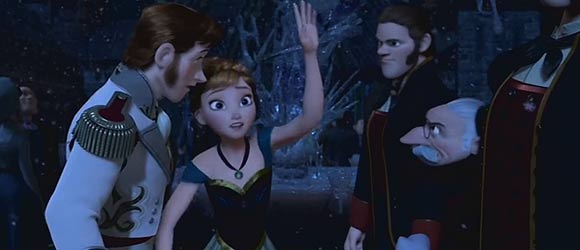 Anna: “Tonight was my fault. I pushed her. So, I’m the one that needs to go after her. Bring me my horse, please.” (30:45) Anna gets on her royal horse and races out of Arendelle in search of her runaway sister. This is the movie’s first example of strong acting. Ideally, an animator should be able to freeze frame a character at any time and ask, “What are you doing?” The character should be able to answer in theatrical terms: Action in pursuit of (provable) objective while overcoming an obstacle. If we freeze frame Anna the moment she calls for her horse, her answer would be: “My objective is to find Elsa; my action is to get on my royal horse and locate her; my obstacle/conflict is with the situation.” Everything up to this point in the movie, the entire first half hour, has been backstory, the movie equivalent of videogame cutscenes.
Anna: “Tonight was my fault. I pushed her. So, I’m the one that needs to go after her. Bring me my horse, please.” (30:45) Anna gets on her royal horse and races out of Arendelle in search of her runaway sister. This is the movie’s first example of strong acting. Ideally, an animator should be able to freeze frame a character at any time and ask, “What are you doing?” The character should be able to answer in theatrical terms: Action in pursuit of (provable) objective while overcoming an obstacle. If we freeze frame Anna the moment she calls for her horse, her answer would be: “My objective is to find Elsa; my action is to get on my royal horse and locate her; my obstacle/conflict is with the situation.” Everything up to this point in the movie, the entire first half hour, has been backstory, the movie equivalent of videogame cutscenes.
Note Hans’s demeanor in this sequence. There does not appear to be a devious thought in his head, only sincere concern for Anna’s safety. Re-wind a bit to Hans’s first entrance in the movie (the sequence with him and Anna playfully tumbling around in the rowboat). No indication of any ulterior motives. Also, watch Hans in the coronation sequence (25:44), when Anna leads him by the hand to get Elsa’s blessings on their prospective marriage. Again, Hans is mentally a blank slate. In order for the animator to deliver a strong performance for Hans, the character’s criminal objective would have to be taken into account because everything that happens, including all of this surprising ice and snow, will cause him to adjust the actions he is taking in pursuit of that objective. If we freeze frame Hans at any point before Act III and ask him, “What are you doing?” he would not have a theatrically valid answer.
Regarding this particular acting lesson, which is base line for character animators, Hans might answer at various times, “I’m confused,” “I’m excited,” “I’m worried,” etc. That may be true, but those are emotional states and are not theatrically valid answers. Acting is doing. If a character is not doing anything to achieve a definable and provable objective, he is not acting. Emotion tends to lead to action.
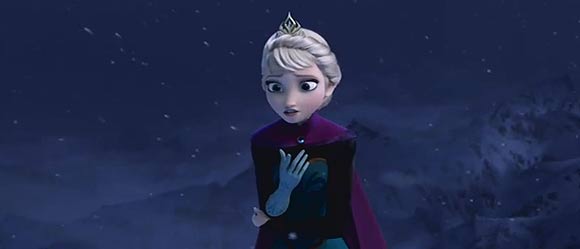 Elsa on North Mountain sings “Let it Go.” (31:09) Objective: To construct a fortress. Action in pursuit of that objective is tossing away the glove, cape and giving total free rein to her magic powers. Conflict is with her situation. The fact that she is climbing a steep mountain rather than walking on easy-to-navigate flat land signals strong conflict. This entire sequence is brilliantly designed and executed, visually and from an acting standpoint. In many ways, it makes the whole movie work. Try to imagine the story without it.
Elsa on North Mountain sings “Let it Go.” (31:09) Objective: To construct a fortress. Action in pursuit of that objective is tossing away the glove, cape and giving total free rein to her magic powers. Conflict is with her situation. The fact that she is climbing a steep mountain rather than walking on easy-to-navigate flat land signals strong conflict. This entire sequence is brilliantly designed and executed, visually and from an acting standpoint. In many ways, it makes the whole movie work. Try to imagine the story without it.
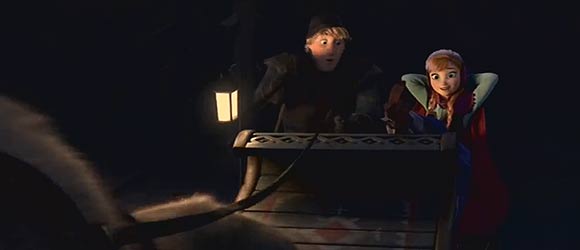 Beginning of sled ride. (40:15) Objective: get to North Mountain. Action and conflict are clear and valid. Then Anna relaxes by putting her feet up on sled – “I like fast,” she explains to Kristoff. This is not a credible thing to be doing. Rough terrain and winter conditions would motivate a person to hold on tighter, not to put her feet up like it is an afternoon drive in Malibu. Acting can be defined as “behaving believably in pretend circumstances for a theatrical purpose.” In this sequence, Anna’s behavior is not believable.
Beginning of sled ride. (40:15) Objective: get to North Mountain. Action and conflict are clear and valid. Then Anna relaxes by putting her feet up on sled – “I like fast,” she explains to Kristoff. This is not a credible thing to be doing. Rough terrain and winter conditions would motivate a person to hold on tighter, not to put her feet up like it is an afternoon drive in Malibu. Acting can be defined as “behaving believably in pretend circumstances for a theatrical purpose.” In this sequence, Anna’s behavior is not believable.
Kristoff and Anna talk. (40:35 To 41:53) And talk. And talk. There is no acting at all in this entire sequence, just some bickering. Maybe the idea was to set up a kind of Bogart and Hepburn African Queen relationship, but it doesn’t work. Kristoff criticizes her for agreeing to marry Hans after knowing him such a short time. His advice on the subject is unsolicited and unnecessary, and we also learn nothing new about Anna’s character during the exchange. The sequence is an interlude, not a scene. What the characters are doing is not correlated with any definable objective.
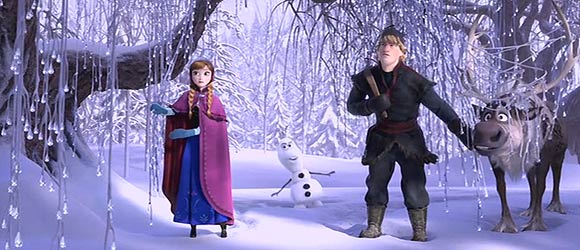 Anna and Kristoff should be aware of Olaf’s presence earlier than they are. (45:35) The little guy is chattering away, literally under their noses, and they still seem not to notice. Obviously, a creative decision was made to have both characters react at the same time, which is a kind of a sight gag. The character behavior, however, is not credible in terms of acting. (A note regarding Olaf: Olaf is a fun character that could probably carry his own movie, a snowman that dreams of beach life and warm sunshine. In the context of Frozen, however, Olaf is an add-on character. The story would work just fine without him.)
Anna and Kristoff should be aware of Olaf’s presence earlier than they are. (45:35) The little guy is chattering away, literally under their noses, and they still seem not to notice. Obviously, a creative decision was made to have both characters react at the same time, which is a kind of a sight gag. The character behavior, however, is not credible in terms of acting. (A note regarding Olaf: Olaf is a fun character that could probably carry his own movie, a snowman that dreams of beach life and warm sunshine. In the context of Frozen, however, Olaf is an add-on character. The story would work just fine without him.)
Anna tries in vain to climb North Mountain. (51:29) The gag is that she is slipping and sliding and making no progress. Although this is not world-class acting, the sequence is theatrically valid for her character because she has an objective, an action and an obstacle.
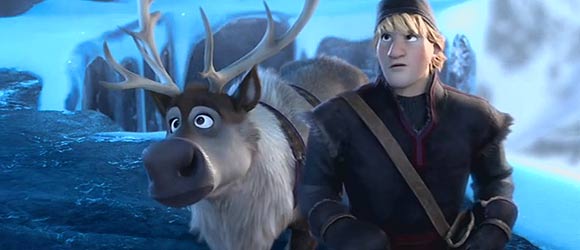 Regarding cross-species animation. Note that Sven the Reindeer exhibits human thought when he nudges Kristoff to take a look at Anna. (51:33) The audience understands that Sven behaves a lot like a Labrador Retriever dog, which is amusing. He is, however, one hundred percent reindeer, and reindeer are not capable of abstract thought. This is the same kind of mistake that Pixar made with the talking dogs in Up and DreamWorks made with the Jerry Seinfeld bee in Bee Movie. It is not okay to bounce around with species attributes in order to conveniently connect narrative dots. If you are going to have a cross-species character, you need to set it up at the top of the story, like Jiminy Cricket in Pinocchio.
Regarding cross-species animation. Note that Sven the Reindeer exhibits human thought when he nudges Kristoff to take a look at Anna. (51:33) The audience understands that Sven behaves a lot like a Labrador Retriever dog, which is amusing. He is, however, one hundred percent reindeer, and reindeer are not capable of abstract thought. This is the same kind of mistake that Pixar made with the talking dogs in Up and DreamWorks made with the Jerry Seinfeld bee in Bee Movie. It is not okay to bounce around with species attributes in order to conveniently connect narrative dots. If you are going to have a cross-species character, you need to set it up at the top of the story, like Jiminy Cricket in Pinocchio.
“BUT, ED, THIS IS ANIMATION!”
Animation may be able to take liberties with the laws of physics, but storytelling basics are the same for animation and live action. The audience and the actors pretend together in a successful theatrical transaction. They will go anywhere the storyteller wants them to go in order to do the pretending, but the rules must be made clear up front, and you cannot change them mid-story. When you change the rules, it amounts to aesthetically pulling the rug out from underneath your audience. In the case of Sven, the audience arrives at the screening knowing that, in some countries, reindeer are food for humans, cows with antlers. If the storytellers had wanted Sven to fly like Superman, the audience would have gone along with it if he was flying when he first appears. It would not work, however, to have him take flight half way up North Mountain in Act II.
In Frozen, Sven starts thinking like a human when the plot needs for him to, and the device was not set up properly. Pixar did this with Merida’s horse in Brave, endowing him with an opportunistic human brain. Remember the scene in which Merida rides out into the woods to meet the witch? Look at it again more closely. The horse is the one that makes the decision to see the witch, not Merida. That is a major structural flaw in that movie. Merida should have made her own choices and then been responsible for them. The horse’s human brain let her off the hook. It is not okay to justify this kind of thing on the grounds that, “This is animation!” Doesn’t matter that it is animation. It is a violation of basic storytelling guidelines.
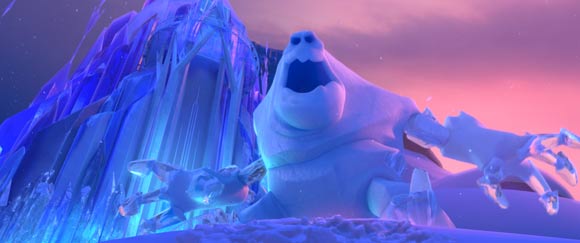 Elsa creates snow monster. (58:20) This was a terrible idea for several reasons, not least of which is that the snow monster gets Elsa off the hook. The moment could have been one of the most powerful in the movie, calling for Elsa to weigh her values against commitment to her sister and her obligations as a queen. The snow monster draws focus away from Elsa at a critical self-discovery moment and is a missed opportunity. In general, it is best to make acting choices that get you into the most trouble. In this case, the acting/writing choice—creation of a brainless snow monster—gave Elsa a way to avoid trouble rather than confront it.
Elsa creates snow monster. (58:20) This was a terrible idea for several reasons, not least of which is that the snow monster gets Elsa off the hook. The moment could have been one of the most powerful in the movie, calling for Elsa to weigh her values against commitment to her sister and her obligations as a queen. The snow monster draws focus away from Elsa at a critical self-discovery moment and is a missed opportunity. In general, it is best to make acting choices that get you into the most trouble. In this case, the acting/writing choice—creation of a brainless snow monster—gave Elsa a way to avoid trouble rather than confront it.
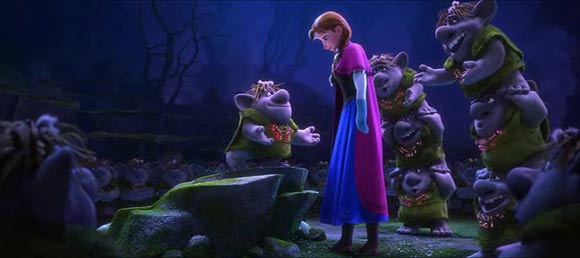 Anna meets Kristoff’s troll family. (01:03:00 to 01:08:00) Musical number. From an acting standpoint, there is not much happening in this sequence. The trolls are cute, and the sequence is expository. If you freeze frame one of them and ask what he or she is doing, there would not be a theatrically valid reply. How Kristoff came to be adopted by trolls in the first place is vague in the screenplay, and I wish the musical number had been used to explain that.
Anna meets Kristoff’s troll family. (01:03:00 to 01:08:00) Musical number. From an acting standpoint, there is not much happening in this sequence. The trolls are cute, and the sequence is expository. If you freeze frame one of them and ask what he or she is doing, there would not be a theatrically valid reply. How Kristoff came to be adopted by trolls in the first place is vague in the screenplay, and I wish the musical number had been used to explain that.
Anna passes out in Kristoff’s arms. (01:08:33) Kristoff now has a fresh objective, namely to save Anna’s life. That is when Grandpa troll provides what amounts to a videogame cutscene moment: “Anna, your life is in danger. There is ice in your heart, put there by your sister. If not removed, the solid ice will make you freeze forever. …only the act of true love can thaw the frozen heart.” Once again, this is a sequence that is mainly expository. A basic rule of screenwriting as well as acting is: “Show; don’t tell.”
 Elsa is taken captive by Hans. (01:12:00) Iron gloves block the magic powers in her hands. She asks Hans to release her. A scene is a negotiation. The sequence would be stronger if we in the audience had known all along that Hans is a sociopath. Instead, we are left to guess at what is going on in his mind. We cannot even be absolutely certain that Hans is the one responsible for taking her captive!
Elsa is taken captive by Hans. (01:12:00) Iron gloves block the magic powers in her hands. She asks Hans to release her. A scene is a negotiation. The sequence would be stronger if we in the audience had known all along that Hans is a sociopath. Instead, we are left to guess at what is going on in his mind. We cannot even be absolutely certain that Hans is the one responsible for taking her captive!

A true love’s kiss… (01:15:00) Note that the audience is still being misled about Hans’s motives, up until the moment when his lips almost meet Anna’s. Then, suddenly, Hans does a 180 degree Jekyll & Hyde-character reversal and admits to being a murderous sociopath. The transition is not even close to being credible because there has been no foreshadowing. “If only there was someone out there who loved you…” Frozen has only fifteen more minutes before final credits, and this is the first overt appearance of a recognizable villain?
Sven the reindeer conveniently develops a human brain again and urges Kristoff to return to Arendelle. (01:19:00) A stronger choice would be to let Kristoff introspect about his feelings for Anna and make his own decision to go back to Arendelle. As was the case when Elsa created the snow monster earlier, Sven’s human brain lets Kristoff off the hook.
Kristoff’s objective is to save Anna. (01:19:30) Action in pursuit of that objective is to get to Arendelle in a hurry, before she turns totally to ice. Conflict is with situation. The sequence is theatrically valid.
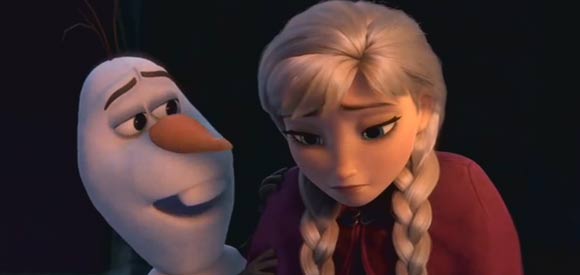 Olaf: “Love is putting someone else’s needs before you – like Kristoff brought you back here to Hans…” (01:21:00) Acting note: show, don’t tell. Acting has almost nothing to do with words. We did not need to hear Olaf enunciate the story’s theme this way. We could have figured it out for ourselves, and it would have been more satisfying emotionally.
Olaf: “Love is putting someone else’s needs before you – like Kristoff brought you back here to Hans…” (01:21:00) Acting note: show, don’t tell. Acting has almost nothing to do with words. We did not need to hear Olaf enunciate the story’s theme this way. We could have figured it out for ourselves, and it would have been more satisfying emotionally.
Anna sacrifices her life for that of her sister. (01:26:00) Then Elsa’s tears melt Anna’s frozen heart, bringing her back to life. These events work theatrically and emotionally. Actions, objectives and obstacles are clear. Actions are dominant over words. We see what the characters do theatrically, which is cathartic and satisfying.
CONCLUSION: A FEW NOTES ABOUT MOOD AND THE ‘ILLUSION OF LIFE’
It is not enough to endow a character with an illusion of life. Back in Frank and Ollie’s day, that might have been sufficient because the skill was revolutionary, but it is not enough in 2014. We now know that there is a difference between theatrical reality and regular reality. In regular reality, you show one hundred percent of everything. What you see at the mall and supermarket is regular reality. You could have an entire cast of characters endowed with an illusion of life, and if they were only shopping at the supermarket, you would bore the audience. Theatrical reality has structure and is selective, showing only the parts of reality that are necessary for telling the story and illuminating character.
There is a widely held misconception among animators that, if they can endow their character with emotion and an illusion of life, that equates to good acting. The fact is that mood is not acting at all, and emotion alone has zero theatrical value. There are sequences in Frozen during which Anna or Elsa is alone and depressed, very sad (see 10:40, end of “Do You Want to Build a Snowman?”). Those are moments in time, expertly animated, but they are only that. As a character animator, you do not want to hang your acting hat on a moment during which the audience is feeling sorry for your character. Yes, the audience can empathize with a character being sad but, in life, emotion tends to lead to action. The longer the mood and negative behavior persist, the further removed will be the possibility of the audience feeling empathy.
In terms of her character arc, Anna only partially achieves her stated objective. She does indeed find her sister, and she does try to talk Elsa into returning to Arendelle—but she is unsuccessful. Elsa’s character transformation happens because Anna turns into a piece of ice, the implication being that she is dead. Elsa killed Anna and is overcome with grief.
It is Elsa’s remorse and bitter tears over her own shortcomings that bring Anna back from the dead. In my view, Frozen would have worked better artistically if Anna and Elsa had been given free reign to go at one another without snow monsters or psychopaths getting in the way. The audience would have learned that, ultimately, we humans must not depend upon magic in order to survive. We must work it out ourselves.

.png)